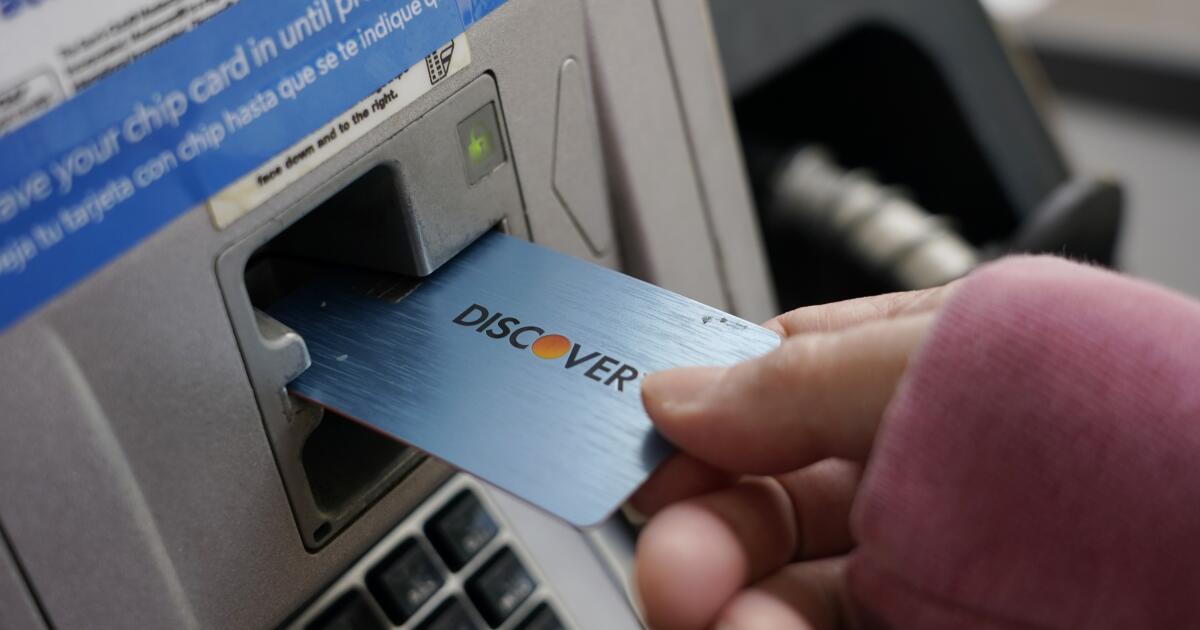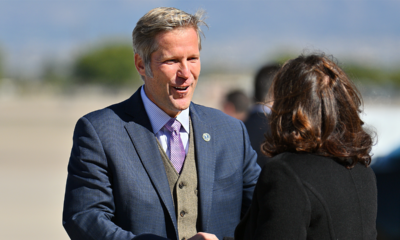Business
What does the Capital One-Discover deal mean for you?

Capital One Financial Corp. announced Monday that it had reached an agreement to acquire Discover Financial Services for $35.3 billion, instantly creating a financial behemoth should the deal be approved by regulators.
The merger would combine one of the largest issuers of Visa and Mastercards with Discovery’s network of cardholders. However, such a mega-merger immediately raised antitrust concerns, as well as questions over how it might affect customers.
Here are some early answers to key questions.
Will I still be able to use my Discover card?
The proposed merger could take a year or more to gain regulatory approval, so in the immediate term don’t expect any changes as it’s reviewed. The companies have not yet disclosed how they might change their product mix. It’s possible Capital One might issue new Discover cards highlighting its name instead of Discover’s bright orange “O” logo — similar to how it issues its Visa and Mastercard credit cards.
However, don’t expect your card to go away. Capital One is buying a valuable asset.
What if I use a Capital One Visa or Mastercard?
Capital One is one of the largest issuers of Visa and Mastercard credit cards in the nation and that is not expected to change, at least for some time. Michael Rhodes, chief executive of Discover, said the deal “brings together two strong brands with enhanced ability to accelerate growth.”
If I can keep my existing credit cards, what is the thinking behind the deal?
Capital One has grown rapidly since it was founded in 1994 and is now one of the nation’s largest banks. A big part of that growth has been its issuance of credit cards by the nation’s two leading card networks, Visa and Mastercard, with a focus on subprime customers who carry balances. Now, with Discover, it would also own its own network, similar to how American Express issues its cards.
What is the advantage for Capital One of owning a credit card network?
Discover, originated by Sears in the mid-1980s to get into the financial services business, has a network of 70 million merchant acceptance points in more than 200 countries and territories, according to the deal announcement. Capital One said the deal is a “key foundation” in its “quest to build a global payments company.”
Still, Discover is the smallest of the four U.S. global payments networks, also trailing American Express. The merger could allow it to expand rapidly and contribute significant profits to Capital One.
What are some of the downsides to the deal?
Consumer advocates are wary of large mergers, especially in the financial services industry, contending it can lead to higher costs for consumers in the form of interest rates and fees, whether in the insurance, mortgage or credit card markets. Also, critics say, larger financial institutions tend to have inferior customer service. Discover, which has focused on prime customers with better credit ratings, has a reputation for superior customer service.
Is anyone opposing the merger?
The National Community Reinvestment Coalition immediately came out against the deal, noting that a report last week by the Consumer Financial Protection Bureau found that small banks and credit unions offered credit cards with significantly lower interest rates than large banks in the first half of 2023.
“This deal is not likely to create public benefits that outweigh its adverse effects. On that basis, we’re opposing it and would encourage regulators to block it,” NCRC Chief Executive Jesse Van Tol said.
How will shareholders make out?
The merger is structured as an all-stock deal, with Discover shareholders receiving 1.0192 Capital One shares for each of their Discover shares. That would give Discover shareholders a 26.6% premium, based on Discover’s closing price of $110.49 on Friday. When the merger closes, Capital One shareholders would own about 60% of the combined company, and Discover shareholders the rest.
What is the chance that such a large merger will be approved by regulators?
The deal could come under increased scrutiny by the Office of the Comptroller of the Currency (OCC) under a proposal last month by the regulator to give it more time and expand its criteria for reviewing mergers. That follows an announcement last summer by the Federal Reserve that indicated it also may strengthen merger oversight following the crisis last year that saw the failures of Silicon Valley Bank and other regional lenders.
Does Capital One have anything to worry about?
Capital One was fined $80 million by the OCC in 2020 for lapses in its failure to establish what it called “effective risk assessment processes” prior to moving information technology operations to the cloud — and then failing to correct the deficiencies in a timely manner. It was previously fined $100 million in 2018 by the regulator for deficiencies in the bank’s anti-money-laundering program.
What about Discover?
The company has just gone through management turmoil. Chief Executive Roger Hochschild resigned in August after the company said that it misclassified some credit card accounts into its highest pricing tier as far back 2007, which resulted in merchants being charged more for accepting the cards for payment. The board vowed to improve the company’s governance.

Business
U.S. Space Force awards $1.6 billion in contracts to South Bay satellite builders

The U.S. Space Force announced Friday it has awarded satellite contracts with a combined value of about $1.6 billion to Rocket Lab in Long Beach and to the Redondo Beach Space Park campus of Northrop Grumman.
The contracts by the Space Development Agency will fund the construction by each company of 18 satellites for a network in development that will provide warning of advanced threats such as hypersonic missiles.
Northrop Grumman has been awarded contracts for prior phases of the Proliferated Warfighter Space Architecture, a planned network of missile defense and communications satellites in low Earth orbit.
The contract announced Friday is valued at $764 million, and the company is now set to deliver a total of 150 satellites for the network.
The $805-million contract awarded to Rocket Lab is its largest to date. It had previously been awarded a $515 million contract to deliver 18 communications satellites for the network.
Founded in 2006 in New Zealand, the company builds satellites and provides small-satellite launch services for commercial and government customers with its Electron rocket. It moved to Long Beach in 2020 from Huntington Beach and is developing a larger rocket.
“This is more than just a contract. It’s a resounding affirmation of our evolution from simply a trusted launch provider to a leading vertically integrated space prime contractor,” said Rocket Labs founder and chief executive Peter Beck in online remarks.
The company said it could eventually earn up to $1 billion due to the contract by supplying components to other builders of the satellite network.
Also awarded contracts announced Friday were a Lockheed Martin group in Sunnyvalle, Calif., and L3Harris Technologies of Fort Wayne, Ind. Those contracts for 36 satellites were valued at nearly $2 billion.
Gurpartap “GP” Sandhoo, acting director of the Space Development Agency, said the contracts awarded “will achieve near-continuous global coverage for missile warning and tracking” in addition to other capabilities.
Northrop Grumman said the missiles are being built to respond to the rise of hypersonic missiles, which maneuver in flight and require infrared tracking and speedy data transmission to protect U.S. troops.
Beck said that the contracts reflects Rocket Labs growth into an “industry disruptor” and growing space prime contractor.
Business
California-based company recalls thousands of cases of salad dressing over ‘foreign objects’

A California food manufacturer is recalling thousands of cases of salad dressing distributed to major retailers over potential contamination from “foreign objects.”
The company, Irvine-based Ventura Foods, recalled 3,556 cases of the dressing that could be contaminated by “black plastic planting material” in the granulated onion used, according to an alert issued by the U.S. Food and Drug Administration.
Ventura Foods voluntarily initiated the recall of the product, which was sold at Costco, Publix and several other retailers across 27 states, according to the FDA.
None of the 42 locations where the product was sold were in California.
Ventura Foods said it issued the recall after one of its ingredient suppliers recalled a batch of onion granules that the company had used n some of its dressings.
“Upon receiving notice of the supplier’s recall, we acted with urgency to remove all potentially impacted product from the marketplace. This includes urging our customers, their distributors and retailers to review their inventory, segregate and stop the further sale and distribution of any products subject to the recall,” said company spokesperson Eniko Bolivar-Murphy in an emailed statement. “The safety of our products is and will always be our top priority.”
The FDA issued its initial recall alert in early November. Costco also alerted customers at that time, noting that customers could return the products to stores for a full refund. The affected products had sell-by dates between Oct. 17 and Nov. 9.
The company recalled the following types of salad dressing:
- Creamy Poblano Avocado Ranch Dressing and Dip
- Ventura Caesar Dressing
- Pepper Mill Regal Caesar Dressing
- Pepper Mill Creamy Caesar Dressing
- Caesar Dressing served at Costco Service Deli
- Caesar Dressing served at Costco Food Court
- Hidden Valley, Buttermilk Ranch
Business
They graduated from Stanford. Due to AI, they can’t find a job

A Stanford software engineering degree used to be a golden ticket. Artificial intelligence has devalued it to bronze, recent graduates say.
The elite students are shocked by the lack of job offers as they finish studies at what is often ranked as the top university in America.
When they were freshmen, ChatGPT hadn’t yet been released upon the world. Today, AI can code better than most humans.
Top tech companies just don’t need as many fresh graduates.
“Stanford computer science graduates are struggling to find entry-level jobs” with the most prominent tech brands, said Jan Liphardt, associate professor of bioengineering at Stanford University. “I think that’s crazy.”
While the rapidly advancing coding capabilities of generative AI have made experienced engineers more productive, they have also hobbled the job prospects of early-career software engineers.
Stanford students describe a suddenly skewed job market, where just a small slice of graduates — those considered “cracked engineers” who already have thick resumes building products and doing research — are getting the few good jobs, leaving everyone else to fight for scraps.
“There’s definitely a very dreary mood on campus,” said a recent computer science graduate who asked not to be named so they could speak freely. “People [who are] job hunting are very stressed out, and it’s very hard for them to actually secure jobs.”
The shake-up is being felt across California colleges, including UC Berkeley, USC and others. The job search has been even tougher for those with less prestigious degrees.
Eylul Akgul graduated last year with a degree in computer science from Loyola Marymount University. She wasn’t getting offers, so she went home to Turkey and got some experience at a startup. In May, she returned to the U.S., and still, she was “ghosted” by hundreds of employers.
“The industry for programmers is getting very oversaturated,” Akgul said.
The engineers’ most significant competitor is getting stronger by the day. When ChatGPT launched in 2022, it could only code for 30 seconds at a time. Today’s AI agents can code for hours, and do basic programming faster with fewer mistakes.
Data suggests that even though AI startups like OpenAI and Anthropic are hiring many people, it is not offsetting the decline in hiring elsewhere. Employment for specific groups, such as early-career software developers between the ages of 22 and 25 has declined by nearly 20% from its peak in late 2022, according to a Stanford study.
It wasn’t just software engineers, but also customer service and accounting jobs that were highly exposed to competition from AI. The Stanford study estimated that entry-level hiring for AI-exposed jobs declined 13% relative to less-exposed jobs such as nursing.
In the Los Angeles region, another study estimated that close to 200,000 jobs are exposed. Around 40% of tasks done by call center workers, editors and personal finance experts could be automated and done by AI, according to an AI Exposure Index curated by resume builder MyPerfectResume.
Many tech startups and titans have not been shy about broadcasting that they are cutting back on hiring plans as AI allows them to do more programming with fewer people.
Anthropic Chief Executive Dario Amodei said that 70% to 90% of the code for some products at his company is written by his company’s AI, called Claude. In May, he predicted that AI’s capabilities will increase until close to 50% of all entry-level white-collar jobs might be wiped out in five years.
A common sentiment from hiring managers is that where they previously needed ten engineers, they now only need “two skilled engineers and one of these LLM-based agents,” which can be just as productive, said Nenad Medvidović, a computer science professor at the University of Southern California.
“We don’t need the junior developers anymore,” said Amr Awadallah, CEO of Vectara, a Palo Alto-based AI startup. “The AI now can code better than the average junior developer that comes out of the best schools out there.”
To be sure, AI is still a long way from causing the extinction of software engineers. As AI handles structured, repetitive tasks, human engineers’ jobs are shifting toward oversight.
Today’s AIs are powerful but “jagged,” meaning they can excel at certain math problems yet still fail basic logic tests and aren’t consistent. One study found that AI tools made experienced developers 19% slower at work, as they spent more time reviewing code and fixing errors.
Students should focus on learning how to manage and check the work of AI as well as getting experience working with it, said John David N. Dionisio, a computer science professor at LMU.
Stanford students say they are arriving at the job market and finding a split in the road; capable AI engineers can find jobs, but basic, old-school computer science jobs are disappearing.
As they hit this surprise speed bump, some students are lowering their standards and joining companies they wouldn’t have considered before. Some are creating their own startups. A large group of frustrated grads are deciding to continue their studies to beef up their resumes and add more skills needed to compete with AI.
“If you look at the enrollment numbers in the past two years, they’ve skyrocketed for people wanting to do a fifth-year master’s,” the Stanford graduate said. “It’s a whole other year, a whole other cycle to do recruiting. I would say, half of my friends are still on campus doing their fifth-year master’s.”
After four months of searching, LMU graduate Akgul finally landed a technical lead job at a software consultancy in Los Angeles. At her new job, she uses AI coding tools, but she feels like she has to do the work of three developers.
Universities and students will have to rethink their curricula and majors to ensure that their four years of study prepare them for a world with AI.
“That’s been a dramatic reversal from three years ago, when all of my undergraduate mentees found great jobs at the companies around us,” Stanford’s Liphardt said. “That has changed.”
-

 Iowa6 days ago
Iowa6 days agoAddy Brown motivated to step up in Audi Crooks’ absence vs. UNI
-

 Iowa1 week ago
Iowa1 week agoHow much snow did Iowa get? See Iowa’s latest snowfall totals
-

 Maine4 days ago
Maine4 days agoElementary-aged student killed in school bus crash in southern Maine
-

 Maryland6 days ago
Maryland6 days agoFrigid temperatures to start the week in Maryland
-

 Technology1 week ago
Technology1 week agoThe Game Awards are losing their luster
-

 South Dakota6 days ago
South Dakota6 days agoNature: Snow in South Dakota
-

 New Mexico4 days ago
New Mexico4 days agoFamily clarifies why they believe missing New Mexico man is dead
-

 Nebraska1 week ago
Nebraska1 week agoNebraska lands commitment from DL Jayden Travers adding to early Top 5 recruiting class




















